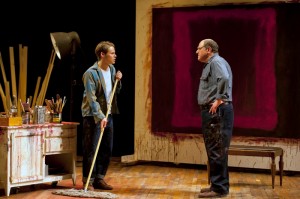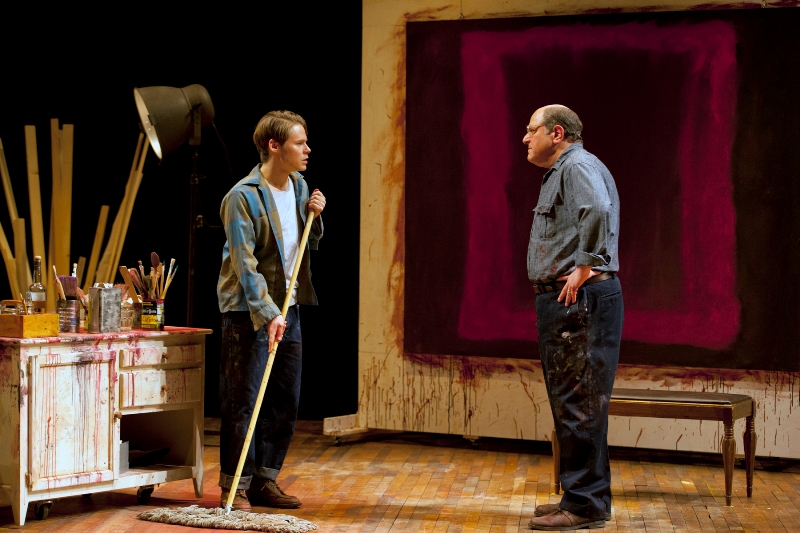
Randy Harrison and Bob Ari in a scene from George Street Playhouse's production of RED. (Photo credit: T. Charles Erickson)
There’s a cliché about life, art, and imitation. It posits a quaint notion about how our lives come to follow similar story lines as the art meant to reflect and critique human experience. Of course, one can only imitate something that one is not, and so John Logan’s RED would argue that this convenient aphorism relies upon a false dichotomy. Through the character of renowned modernist painter Mark Rothko, this play suggests that life very much is art.
When the lights come up on the George Street Playhouse’s production of RED, Bob Ari, as Rothko, stands at the very edge of the stage in silence, smoking a cigarette and staring into the theater. We soon learn that the character is examining an invisible fourth wall that holds a painting in progress, but it is not until much later in the show that we come to understand what he is looking for: the deepest and most terrifying contours of the human experience. Exasperated by a nation he finds to have lost all sense of discernment, “living under the tyranny of ‘fine,’” Rothko aspires for his art to expose all that is wretched, tawdry, and therefore grotesquely glorious about our everyday lives. He aspires, that is, to be Nietzsche with a paintbrush.
In Mr. Logan’s highly acclaimed play, Rothko is haunted less by his need to explore the depths of humanity than he is by the horrifying reality that so few of his fellow humans—and so little of his art’s audience—share this search for understanding. In the supple young mind of his new assistant, Ken, Rothko may have found an avenue through which to pass his longing to a younger generation. George Street’s excellent production, insightfully directed by Anders Cato and made vivid by two dynamic performances, shows us Rothko mired in this constant tension as he works on an ambitious project with the help of his bright-eyed new assistant. Over the course of the play, Ken becomes Rothko’s human canvas, and we watch as the master painter uses art to examine humanity.
The time is 1958, and the project in question is Rothko’s Seagram murals, a bold commission of grand scale meant to populate the walls of New York’s newest and most opulent restaurant. Rothko is hard at work on the project when Ken, an Iowa hayseed in the big city to study art, arrives for his first day of work as the master’s new assistant. “What do you see?” demands a gruff but frank Rothko of Ken, who stands wide-eyed and perplexed in front of one of the artist’s challenging pictures. Before letting the youth answer, Rothko will tell him where and how to stand, instruct him how to look and think properly, and demand above all that he “be a human being” with empathy for the picture. This first exchange between the play’s only two characters is emblematic of how their relationship progresses over the course of the play: Rothko as the self-assured and at-times overbearing professor, and Ken as the object of lessons he’s not always aware he is learning. Ken arrives to the studio simply as an assistant to mix paint, stretch canvas, and fetch cigarettes, but he becomes pupil to Rothko’s view of a world that needs art to reign in capricious humanity.
Along with that easy cliché about art, life, and imitation, RED allows room for that other well-worn platitude about who is teaching whom in the master-pupil relationship, but the combined force of Mr. Cato’s steady direction and Mr. Ari’s commanding performance wisely squash that question. This Rothko may be manic, domineering, and at-times pedantic, but he is always in control of his studio. Mr. Ari gives us a Rothko that ranges from stalking bear to patient instructor, but always present is a critical self-awareness, an efficiency of purpose that understands the goal and has long-since decided the best method of reaching it. Unromantic about his work or his life, Rothko proceeds through the play buttressed by a confidence and certainty that wavers only once. That moment of doubt and hesitation provides the play’s most dramatic moment, at which time Mr. Ari embodies wonderfully all of Rothko’s horrifying bewilderment.
Sharing space with a character as controlling as this Rothko, Randy Harrison’s Ken often finds himself scrambling for a voice of any consequence, a search which RED makes a centerpiece. Mr. Harrison takes Ken from meek and tentative to vocal and self-assured in a maturation that we recognize as guided at all times by Rothko. Mr. Harrison thus admirably rises to the challenge of showing us a Ken who is so very certain of coming into his own, while never actually reaching intellectual independence. The pace of the play (two years covered in a brisk ninety minutes) forces an unfortunate abruptness to Ken’s development, but Mr. Harrison does well to underscore the various stages of Ken’s uncertainty, frustration, and budding confidence.
These two excellent performances notwithstanding, much of the height to which George Street’s RED ascends results from the sensitive, fluid, and at times maestro-like direction of Mr. Cato. With only two actors and an effectively claustrophobic playing space, the directorial challenge here is to find vibrancy and movement for these characters—the very things Rothko seeks for his paintings. Mr. Cato’s wonderfully dynamic vision results in his actors’ seemingly effortless and natural navigation of the stage, at times flowing from one work space to another, and at others standing in a stiff tension that has been heightened by the rest of the production’s pulsation.
Rich, challenging, sensitive, and often quite funny, RED, like Rothko, uses art as a window into the fraught human condition. In the deep red of Rothko’s Seagram murals, Mr. Logan finds blood pulsating in the hopes of understanding and of human connection. “There’s tragedy in every brushstroke,” the master tells his pupil at one point. Tragedy can only exist if there is something truly at stake hanging in the balance, and in its sympathy for the human condition, RED suggests that at stake here is the horrifying audacity to look within, to look—to and really look—at art.
RED
By John Logan
Directed by Anders Cato
January 31–February 26, 2012
George Street Playhouse
9 Livingston Avenue
New Brunswick, NJ, 08901
732-246-7717
http://www.georgestreetplayhouse.org/



2 comments
A wonderful and astute review—thank you!
[…] stagemagazine.org VN:F [1.9.13_1145]please wait…Rating: 0.0/5 (0 cast)Filled under category Randy Harrison and […]